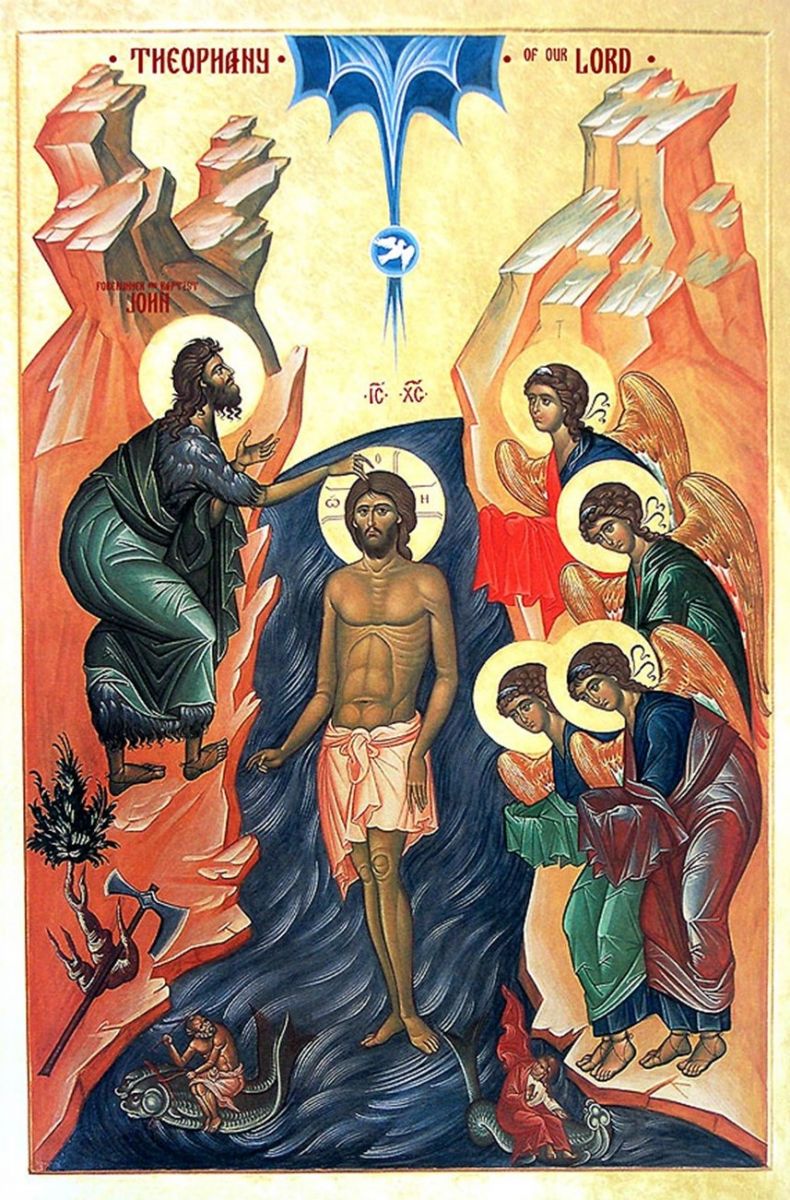- Home
- About us
- Students
- Courses
- Research
- Library
- News & Events
- Gallery
- Contact
- Our Blog
Latest News

The Unfolding of the Divine Drama of Salvation:
Scripture, Hymnody and Iconography
in the Orthodox Liturgical Celebration of Theophany

by Dr Lydia Gore-Jones (Senior Lecturer in Biblical Studies - Old Testament)
In the season of Theophany, the worshipper in church sees with her own eyes and hears with her own ears the unfolding of the divine drama of our salvation, and is invited to take part in it. Yes, I am speaking about the sacred, sublime and utterly amazing liturgical acts of the Orthodox Church celebrating the manifestation of God in the flesh and His triumphal rescue of the human race, as Jesus Christ comes to the Jordan River to be baptised by John the Forerunner.
It is not just the commemoration of a historical event, but the liturgical enactment of the Divine Comedy, live on the cosmic stage, a mystical reality that wraps us up in itself. This mystical reality is revealed in the Church’s liturgy through the rich tapestry bearing the image of Christ, made with interwoven threads of Scripture, hymnody and iconography.
That reality is first visually presented to us in the icon of Theophany. The naked body of Jesus stands in the midst of the river, dividing the waters. The halo bears the name of the God of old who spoke to Moses in the wilderness, parted the waters of the Red Sea for the Israelites, and turned rock into a spring of water for the wandering people. John the Baptiser bears witness with his right hand pointing at the Lord now appeared in the Jordan, and the other hand in the gesture of praise, looking up as if hearing a voice from heaven. Following his eyes one sees the opening of Heaven, and the Spirit in the form of a dove hovering above Jesus and the water. The angels attend to Him in worship. The mountains and hills shake. The dark forces, personified as small figures lurking in the water, flee from before His face. The bush with an axe on it at John’s feet seem to resound these words, “The time is fulfilled, and the kingdom of God is at hand; repent, and believe in the gospel” (Mark 1:15); “behold, even now the axe is laid to the root of the trees; every tree therefore that does not bear good fruit is cut down and thrown into the fire” (Matthew 2:10; Luke 3:9).
People are right to identify the scripture basis of the icon to be the narratives of the Gospel books. But wait, at the heart of the image is also the prophecy of Psalm 114 (LXX 113):
When Israel went out from Egypt,
the house of Jacob from a people of strange language,
Judah became God’s sanctuary,
Israel his dominion.
The sea looked and fled;
Jordan turned back.
The mountains skipped like rams,
the hills like lambs.
Why is it, O sea, that you flee?
O Jordan, that you turn back?
O mountains, that you skip like rams?
O hills, like lambs?
Tremble, O earth, at the presence of the Lord,
at the presence of the God of Jacob,
who turns the rock into a pool of water,
the flint into a spring of water.
The psalm identifies the one in the midst of the water to be the God of Creation and Exodus of the Old Testament. Not only that the scene in the psalm is vividly captured in the icon, its verse is also chanted repeatedly in each of the Hours in the Royal Hours service, in anticipation of the great feast. One of the hymns sings:
Today, it is the time for the prophecy of the Psalms to take effect; for it says that the sea beheld and ran away; and Jordan turned back from the face of the Lord, from the face of the God of Jacob, Who comes to accept baptism from a servant, so that having been washed from abominable idolatry, our souls may be illuminated by Him.[1]
What the icon depicts, therefore, is none other than the prophecy of Scripture now coming into realisation and God’s mighty act of salvation unfolding before our eyes and ears. The sacred hymnody of the Church, on the other hand, unpacks, describes, discloses and interprets this divine mystic reality to us, for us to comprehend the awesome Divine Comedy, and to call on us to become part of God’s act.
Everyone, even of inanimate things, has a part to play in this divine drama:
River Jordan is “sore amazed,” saying, “He, Whom none can see, I saw naked, and I feared. How should I not be afraid before Him and turn back?”[2]
“I cannot bear a consuming fire,” River Jordan moans, “I am not accustomed to wash the Pure, the sinless one.”[3]
Angels tremble with fear and awe; heaven is amazed; the earth with quaking shakes, the sea draws back in dread with all things both visible and invisible, at the appearance of Christ. The Spirit testifies by His presence. The heavenly voice of the Father cries, saying, “This One, on Whom the Forerunner places his hands, is My beloved Son in Whom I am well pleased!”[4]
And we hear John, seized with trembling, crying out aloud,
“O Lord, you have come, taking the form of a servant, and you who know not sin asks for baptism. How shall the lamp illumine the Light? How shall the servant set his hand upon the Master? O Saviour Who takes away the sin of the world, sanctify both me and the waters!”[5]
To that, our Lord, the Divine Warrior, says:
“Touch my divine head and falter not, O Prophet. Be not doubtful, for verily, I have come to destroy the Archon of darkness, the Contender, who hides in the waters, now rescuing the world from his traps, and granting eternal life, since I am the Lover of Mankind.”[6]
Again and again, the hymns of the Church invite us to contemplate the paradoxes of the divine drama. Being the Master, He bows His head to a servant, to “make us sons of God instead of servants.”[7] Being the Maker of heaven and earth cloaked in light and majesty, He is naked in the river, in order to clothe Adam again “in the first robe” of righteousness which he had lost to sin.[8]
Again and again, the hymns proclaim to the universe that Christ has appeared in the Jordan,
to make the worship of the Holy Trinity manifest!
to sanctify the waters!
to illumine us sitting in the dark dungeon!
to crush the head of the dragon!
to deliver us from all the wiles of the dragon and his gins!
to save Adam the first-formed man!
to renew creation!
Again and again, the voices of the prophets and saintly apostles tell us that our baptism is the baptism of water and the Holy Spirit, the baptism in the name of the Holy Trinity, the baptism of Christ’s burial and resurrection. We are called upon to become partakers of this divine mystery:
Come ye all, and receive the Spirit of wisdom, the Spirit of understanding, the Spirit of the fear of God, from Christ Who is made manifest.[9]
To that invitation we have come, we have seen and heard the marvellous mystery; and we join the powers of heaven in amazement and in awe, crying with them: “Glory to God Who has appeared, and has been seen upon earth, and has enlightened the world!”[10]
[1] Idiomela for the Sixth Hour, in Tone Six.
[2] Orthros Kathismata of the Theophany in Tone Four.
[3] Ideomela for the Sixth Hour in Tone Five.
[4] Vespers, “O Lord I Have Cried” Verse 4.
[5] Idiomela of the First Hour in Tone Eight.
[6] Idiomela for the Sixth Hour in Tone Eight.
[7] Idiomela for the Nineth Hour in Tone Two.
[8] Apolytikion of the Forefeast.
[9] The Service for the Great Sanctification of Water, Idiomela in Tone Eight.
[10] Orthros, the Doxastica for the Theophany of Christ in Tone Two.



.png)